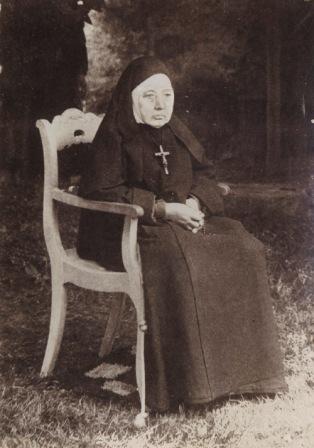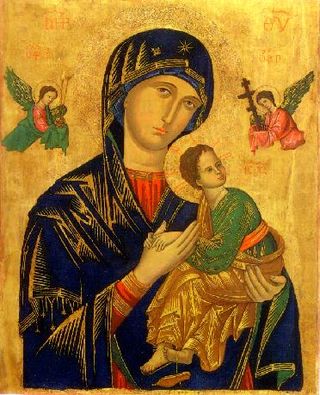Related Research Articles

The Immaculate Conception is the belief that the Virgin Mary was free of original sin from the moment of her conception. It is one of the four Marian dogmas of the Catholic Church. Debated by medieval theologians, it was not defined as a dogma until 1854, by Pope Pius IX in the papal bull Ineffabilis Deus. While the Immaculate Conception asserts Mary's freedom from original sin, the Council of Trent, held between 1545 and 1563, had previously affirmed her freedom from personal sin.
In the Catholic Church, holy days of obligation or precepts are days on which the faithful are expected to attend Mass, and engage in rest from work and recreation, according to the third commandment.

The Litany of the Blessed Virgin Mary is a Marian litany originally approved in 1587 by Pope Sixtus V. It is also known as the Litany of Loreto, after its first-known place of origin, the Shrine of Our Lady of Loreto (Italy), where its usage was recorded as early as 1558.

The Solemnity of the Immaculate Conception celebrates the Immaculate Conception of the Blessed Virgin Mary on 8 December, nine months before the feast of the Nativity of Mary on 8 September. It is one of the most important Marian feasts in the liturgical calendar of the Roman Catholic Church.

The Felician Sisters, in full Congregation of Sisters of St. Felix of Cantalice Third Order Regular of St. Francis of Assisi, is a religious institute of pontifical right whose members profess public vows of and live in common. This religious institute was founded in Warsaw, Poland, in 1855, by Angela Truszkowska, and named for a shrine of Saint Felix of Cantalice, a 16th-century Capuchin especially devoted to children.

In Christian liturgy, a vigil is, in origin, a religious service held during the night leading to a Sunday or other feastday. The Latin term vigilia, from which the word is derived meant a watch night, not necessarily in a military context, and generally reckoned as a fourth part of the night from sunset to sunrise. The four watches or vigils were of varying length in line with the seasonal variation of the length of the night.
A Catholic order liturgical rite is a variant of a Catholic liturgical rite distinct from the typical ones, such as the Roman Rite, but instead specific to a certain Catholic religious order.

The Congregation of Marian Fathers of the Immaculate Conception of the Most Blessed Virgin Mary is a Catholic male clerical religious congregation founded, 1670, in Poland. It is also known as Marians of the Immaculate Conception. Its members add the post-nominal letters M.I.C. after their names to indicate membership in the Congregation.

Ineffabilis Deus is an apostolic constitution by Pope Pius IX. It defines the dogma of the Immaculate Conception of the Blessed Virgin Mary. The document was promulgated on December 8, 1854, the date of the annual Solemnity of the Immaculate Conception, and followed from a positive response to the encyclical Ubi primum.

A patronage of the Blessed Virgin Mary is a form of spiritual protection attributed to Mary, mother of Jesus, in favor of some occupations, activities, religious orders, congregations, dioceses, and geographic locations.

Three Hail Marys are a traditional Roman Catholic devotional practice of reciting Hail Marys as a petition for purity and other virtues. Believers recommend that it be prayed after waking in the morning, and before going to bed. This devotion has been recommended by SS. Anthony of Padua, Alphonsus Liguori, John Bosco and Leonard of Port Maurice. Two saints, Mechtilde and Gertrude the Great, are said to have received revelations from the Blessed Virgin Mary regarding this practice.

Mary, the mother of Jesus in Christianity, is known by many different titles, epithets, invocations, and several names associated with places.
Marian feast days in the liturgical year are celebrated in honour of the Blessed Virgin Mary. The number of Marian feasts celebrated, their names can vary among Christian denominations.

Throughout history, Catholic Mariology has been influenced by a number of saints who have attested to the central role of Mary in God's plan of salvation. The analysis of Early Church Fathers continues to be reflected in modern encyclicals. Irenaeus vigorously defended the title of "Theotokos" or Mother of God. The views of Anthony of Padua, Robert Bellarmine and others supported the doctrine of the Immaculate Conception of the Virgin Mary, which was declared a dogma in 1850.

The Mariology of the popes is the theological study of the influence that the popes have had on the development, formulation and transformation of the Roman Catholic Church's doctrines and devotions relating to the Blessed Virgin Mary.

Catholic Marian movements and societies have developed from the veneration of the Blessed Virgin Mary by members of the Catholic Church. These societies form part of the fabric of Mariology in the Catholic Church. Popular membership in Marian organizations grew significantly in the 20th century, as apparitions such as Our Lady of Fátima gave rise to societies with millions of members, and today many Marian societies exist around the world. This article reviews the major Marian movements and organizations.

Stanislaus Papczyński, MIC, born Jan Papczyński and in religion Stanislaus of Jesus and Mary, was a Polish Catholic priest who founded the Marians of the Immaculate Conception, the first Polish religious order for men. He is also widely remembered as a prolific religious writer, including works such as The Mystical Temple of God.

Tadeusz Pikus is a Polish Roman Catholic prelate who was Bishop of Drohiczyn from 2014 to 2019. He was previously Auxiliary Bishop of Warsaw from 1999 to 2014,
References
- ↑ Mszał Rzymski. Warsaw: Wydawnictwo Pallotinum. 2008. pp. 1438–1519. ISBN 978-83-926581-1-5.
- ↑ Mszał Rzymski. Warsaw: Wydawnictwo Pallotinum. 2008. pp. 1438–1519. ISBN 978-83-926581-1-5.
- ↑ Martin, Michael. "Little Office of the Immaculate Conception". Article. Retrieved 2014-02-16.
- ↑ Mszał Rzymski. Warsaw: Wydawnictwo Pallotinum. 2008. pp. 1438–1519. ISBN 978-83-926581-1-5.
- ↑ Martin, Michael. "Little Office of the Immaculate Conception". Article. Retrieved 2014-02-16.
- ↑ United States Conference of Catholic Bishops (10 November 2006). Manual of Indulgences: Norms and Grants. Location 1049: USCCB Publishing. p. 172. ISBN 978-1-57455-474-8.
{{cite book}}: CS1 maint: location (link) - ↑ Mszał Rzymski. Warsaw: Wydawnictwo Pallotinum. 2008. pp. 1438–1519. ISBN 978-83-926581-1-5.
- ↑ Mszał Rzymski. Warsaw: Wydawnictwo Pallotinum. 2008. pp. 1438–1519. ISBN 978-83-926581-1-5.